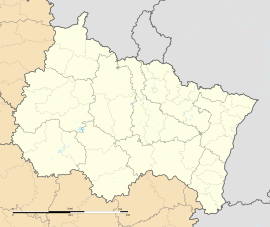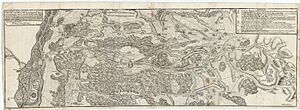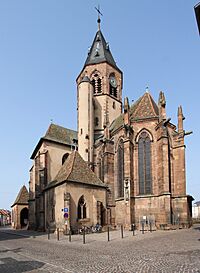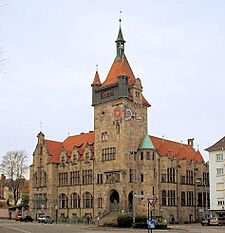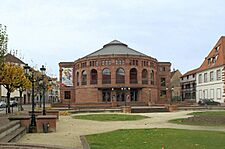Haguenau facts for kids
Quick facts for kids
Haguenau
|
||
|---|---|---|
|
Subprefecture and commune
|
||
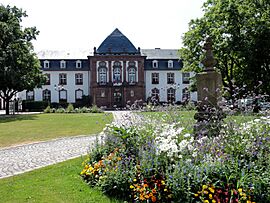
The town hall in Haguenau
|
||
|
||
| Country | France | |
| Region | Grand Est | |
| Department | Bas-Rhin | |
| Arrondissement | Haguenau-Wissembourg | |
| Canton | Haguenau | |
| Intercommunality | CA Haguenau | |
| Area
1
|
182.59 km2 (70.50 sq mi) | |
| Population
(2021)
|
35,715 | |
| • Density | 195.602/km2 (506.607/sq mi) | |
| Time zone | UTC+01:00 (CET) | |
| • Summer (DST) | UTC+02:00 (CEST) | |
| INSEE/Postal code |
67180 /67500
|
|
| Elevation | 115–203 m (377–666 ft) (avg. 150 m or 490 ft) |
|
| 1 French Land Register data, which excludes lakes, ponds, glaciers > 1 km2 (0.386 sq mi or 247 acres) and river estuaries. | ||

Haguenau is a town in the Bas-Rhin area of France. It is a sub-prefecture, which means it's an important administrative center.
Haguenau is the second largest town in Bas-Rhin, after Strasbourg. Strasbourg is about 30 kilometers (18 miles) to the south. North of Haguenau, you'll find the Forest of Haguenau, which is the biggest forest in France that isn't divided up.
This town has a long history of changing hands between Germany and France. Its name even changed between "Hagenau" and "Haguenau" depending on who was in charge. After France lost the Franco-Prussian War in 1871, Haguenau became part of the German Empire. It stayed German for 48 years until the end of World War I in 1918. The Treaty of Versailles in 1919 officially gave it back to France.
Haguenau is growing quickly. Its population increased from about 23,000 people in 1968 to over 35,000 in 2021. The larger area around Haguenau has also grown a lot.
Contents
History of Haguenau
Haguenau began in the early 1100s. Duke Frederick II built a hunting lodge on an island in the Moder River. Later, King and Holy Roman Emperor Frederick I Barbarossa made the settlement stronger. He gave it special "town rights" in 1154, which helped it grow.
Frederick Barbarossa also built an imperial palace where the hunting lodge was. He loved this palace. It even held the "Crown Jewels of the Holy Roman Empire", like the crown, scepter, and sword of Charlemagne.
Becoming an Imperial City
In 1257, Richard of Cornwall, who was King of the Romans, made Haguenau an imperial city. This meant it was directly under the Holy Roman Emperor, not a local lord. Later, Rudolph I of Germany made Haguenau the seat of the Landvogt (a German imperial advocate) for Lower Alsace.
In the 1300s, Haguenau was home to the main council of the Decapole. This was a group of ten towns in Alsace that worked together to protect themselves from attacks and economic problems.
Changes of Control
In 1648, after the Thirty Years' War, Alsace was given to France in the Peace of Westphalia. France had often invaded and looted the area before this. In 1673, King Louis XIV ordered the town's defenses and the remains of the palace to be destroyed. He wanted to remove German traditions.
German troops took Haguenau back in 1675. But two years later, the French took it again. French troops then set fire to the town, almost destroying it. In 1793, during the French Revolution, Prussian and Austrian forces occupied Lower Alsace. But the French army pushed them back across the border.
In 1871, after the Franco-Prussian War, Haguenau became part of the German Empire. Its German spelling, Hagenau, was used again. The Haguenau Airport was built in 1916 by the German military. It was used to train pilots for the First World War. After World War I, Hagenau was briefly part of the independent Republic of Alsace-Lorraine before returning to France in 1919.
Haguenau in World War II
During the Second World War, Germany took control of Haguenau again in 1940. In late 1944, the area around Haguenau was controlled by German forces.
On December 9, 1944, the American 314th Infantry Regiment began an attack to take Haguenau. The Germans left the town on December 10-11, and the Americans took control. Before leaving, the Germans destroyed bridges, buildings, and even the town park.
However, the Germans came back and retook the town in late January 1945. Most people living there fled with help from the U.S. Army. The Americans immediately fought back to retake the town. The fighting continued, with different American divisions involved.
On March 15, 1945, the Allies launched "Operation Undertone." This was a big effort by American and French armies to push the Germans back. The last German soldier was not cleared out of Haguenau until March 19, 1945, after intense house-to-house fighting. Much of the town was destroyed during this time.
Population Growth
| Historical population | |||||||||||||||||||||||||||||||||||||||||||||||||||||||||||||||||||||||||||||||||||||||||||||||||||||||||||||||||||
|---|---|---|---|---|---|---|---|---|---|---|---|---|---|---|---|---|---|---|---|---|---|---|---|---|---|---|---|---|---|---|---|---|---|---|---|---|---|---|---|---|---|---|---|---|---|---|---|---|---|---|---|---|---|---|---|---|---|---|---|---|---|---|---|---|---|---|---|---|---|---|---|---|---|---|---|---|---|---|---|---|---|---|---|---|---|---|---|---|---|---|---|---|---|---|---|---|---|---|---|---|---|---|---|---|---|---|---|---|---|---|---|---|---|---|---|
|
|
||||||||||||||||||||||||||||||||||||||||||||||||||||||||||||||||||||||||||||||||||||||||||||||||||||||||||||||||||
| Source: EHESS and INSEE (1968-2017) | |||||||||||||||||||||||||||||||||||||||||||||||||||||||||||||||||||||||||||||||||||||||||||||||||||||||||||||||||||
The population of Haguenau has changed a lot over the centuries. You can see how it has grown, especially in recent decades.
Economy and Trade
Haguenau has a strong and balanced economy. Its long history, caught between France and Germany, has given it a rich culture. This helps bring in many tourists.
The town also has a busy light manufacturing sector, mostly in the industrial area west of town. There are also many shops nearby, showing that Haguenau is an important place for business in the region. Recent improvements to the ring road have made it easier to get to these areas. This has also helped reduce traffic in the town center.
Places to See
Even though Haguenau was badly damaged in many wars, especially the Thirty Years' War and World War II, it still has buildings from nine centuries. Sadly, nothing is left of Frederick I Barbarossa's grand imperial palace.
Historical Architecture
Medieval Haguenau still has three gates from its old walls:
- the Tour des Chevaliers (Tower of the Knights)
- the Tour des Pêcheurs (Tower of the Fishermen)
- the Porte de Wissembourg (Wissembourg Gate)
It also has two large Gothic churches, Saint-Georges and Saint-Nicolas. There's an old water-mill and the Ancienne Douane (old custom-house). Both Saint-Georges and Saint-Nicolas Church have lost many of their old art pieces. But they still have beautiful altars, choir stalls, and other church furniture. Saint-Nicolas now holds wooden decorations from the destroyed Neubourg Abbey nearby.
From the French Baroque and classicism periods, you can see buildings like the old hospital and the current town hall. The Synagogue (built in 1820) and the municipal theater (built in 1846) are great examples of French Neo-classicism. The large Hop hall was built in 1867 and expanded later.
The Basilica of Our Lady in Marienthal is a huge Gothic Revival church. It has two statues from the early 1400s and many sculptures from around 1519.
Haguenau's streets also have nice fountains. These include the medieval Saint-Georges fountain, the 18th-century Bee fountain, and the 1825 Dolphin fountain.
Museums in Haguenau
- Historical Museum: This is the biggest museum in Bas-Rhin outside of Strasbourg. It's in a grand building that looks like a medieval castle (built in 1905).
- Alsatian Museum: This museum is in the former palace of the chancellor, which is Haguenau's main Renaissance building.
- Baggage Museum: This museum opened in 2016. It's in an old villa from the 1840s that used to be a bank.
Higher Education
The Institut universitaire de technologie de Haguenau (IUT) was started in 2006. It is a part of the University of Strasbourg.
Transportation
Haguenau station connects the town by train to Strasbourg, Wissembourg, and Niederbronn-les-Bains.
Famous People from Haguenau
Many interesting people have come from Haguenau, including:
- Wolfgang Fabricius Capito (1478–1541), a Christian theologian.
- Frederick Barbarossa, an emperor of the Holy Roman Empire.
- Josel of Rosheim (1476–1554), an important Jewish leader.
- Sébastien Loeb (born 1974), a famous rally car driver who won the World Rally Championship nine times.
- Pierre Seel (1923–2005), an activist.
Sister Cities
Haguenau is a twin town with Landau in Germany. This means they have a special friendship and cultural exchange.
Haguenau in Media
- An episode of the World War II TV series Band of Brothers is set in Haguenau. It's the eighth episode of the series.
- In the 1968 movie The Girl on a Motorcycle, the main character starts her journey from Haguenau.
See also
 In Spanish: Haguenau para niños
In Spanish: Haguenau para niños




